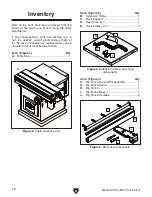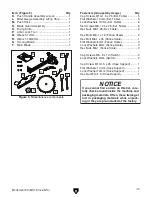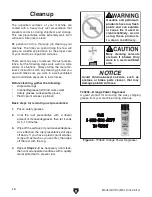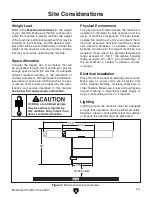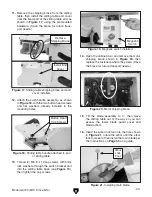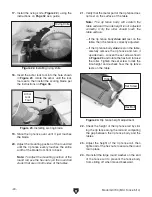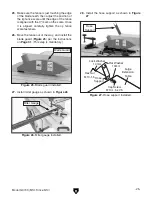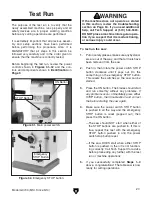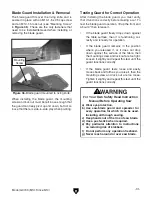
-30-
Model G0700 (Mfd. Since 5/14)
Blade Guard &
Riving Knife
The term "blade guard" refers to the assembly that
consists of the guard and riving knife assembly
(see
Figure below). Each of these components
have important safety functions.
Understanding the Blade Guard
The guard encloses the top of the blade to reduce
the risk of accidental blade contact and contain
flying chips or dust.
The guard is designed to lift as the workpiece is
pushed into the blade, remain in contact with the
workpiece during the cut, then return to a resting
position against the table when the cut is com-
plete. When installed and properly maintained,
the guard is an excellent tool for reducing the risk
of injury when operating the table saw.
To ensure that the guard does its job effectively, it
MUST be installed and adjusted so that it moves
up and down properly to accommodate workpiec-
es and maintain coverage over the blade.
Figure 35. Blade guard assembly components.
Guard
Riving Knife
Understanding the Riving Knife
The riving knife is a metal plate that prevents the
freshly cut pieces of the workpiece from pinching
the backside of the blade and causing a kickback.
It also acts as a barrier behind the blade to shield
hands from being pulled into the blade if a kick-
back occurs and the operator is reaching behind
the blade. (Reaching behind the blade is a major
safety risk and should not be done).
The blade guard MUST be installed on the saw
for all normal through cuts (defined on
Page 31).
Sometimes the blade guard or its components
can get in the way when cutting very narrow
workpieces or other specialized cuts. Because
the blade guard is provided to decrease your risk
of injury, it should not be used if it gets in the way
of making a safe cut. Use good judgment!
In general, the blade guard MUST remain installed
on the saw—unless a specific operation requires
its removal. If the blade guard is removed for
specific operations, always immediately replace it
after those operations are complete.
When to Use the Blade Guard
Use the riving knife without the blade guard for
any non-through cuts (defined on
Page 31) or nar-
row/specialized cuts in which the blade guard gets
in the way of a safe cut.
Always immediately replace the blade guard when
these cuts are complete!
When to Use the Riving Knife Only
If you use a dado blade that has a diameter
smaller than 10", the riving knife will be taller than
the top of the blade, which will prevent the cut
from being completed. In this case, the only way
to complete the cut is to remove the riving knife.
When Not to Use Riving Knife
To ensure that the riving knife works safe-
ly, it MUST be aligned with and correctly
adjusted to the blade.
Summary of Contents for G0700
Page 17: ...Model G0700 Mfd Since 5 14 15 Hardware Recognition Chart...
Page 85: ......

